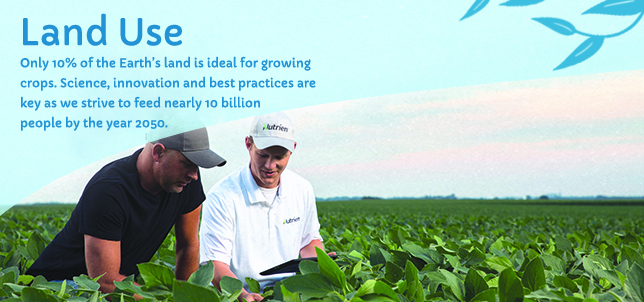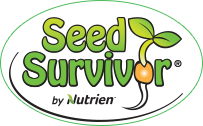
Farmers use Science
If you look at the labels on food at home or in the supermarket, they list nutrients and percentages. Scientists have determined how much of each nutrient an average person needs per day.
One serving of yogurt, for example, provides 5% of the protein an average person needs. And as we use protein or burn carbohydrates and such – we eat to replace them.
Likewise, scientists know how much nitrogen and other nutrients corn needs; or cotton, or soybeans – you name it.
It’s also important to remember that farmers are incredibly smart. They won’t apply (and pay for) more fertilizer than the soil requires – or, to put it another way, more than the next crop needs.
How much land?
Roughly 10% of the earth has ideal growing conditions and this will never get any bigger. It may actually get smaller as our cities expand and our population increases.
We use our land for so many different things and the amount devoted to farming has hardly changed during the past 50 years. Scientists are worried about how we will feed the world’s growing population.
The fact is, there are many different forms of nutrients and they all play an important role in growing food. But, the world must use fertilizers to sustain its growing population.
This is not simply our opinion, but the conclusion of agronomists from around the world.
In the next 25 years, global population will grow from over 7 billion to over 9 billion.
Dr. Norman Borlaug, the Nobel Peace Prize winner, said that “Without commercial fertilizer, we’d have 2 billion more people than the world can feed.”
Not only that, the fact is, today – even with fertilizer – about 2 billion people worldwide are not able to grow or to buy the food they need; 1 out of 3 people does not have what is called “food security.”
So if we already have about 2 billion people today who lack food security – and we add almost 2 billion more people by 2025, we’ll then have nearly 4 billion people in need. Unless, of course, we’re able to double food production by then.
The world’s top scientists tell us that’s impossible to achieve without conventional fertilizer.
It’s possible to grow foods with nutrients from other sources, such as with manures and composting, but the crop yields will not be enough to feed the world. Organic crop yields are typically only one-third to one-half as high as commercial fertilizer crop yields. Manures and organic composts are still excellent nutrient sources. To feed the world, we need to use manures, organic composts and fertilizers.
Despite tremendous technological advances in high yield farming and using conventional fertilizer, the job is far from done.
In the United States and Canada, most people don’t have to worry about having enough to eat. But food security for everyone worldwide is the goal.
Farmers are smart and we’ve actually been able to use nearly 40% of the earth’s surface for agriculture – raising livestock on land that is too hilly or rocky for crops, growing urban gardens, planting seeds that grow in tough conditions like drought and using technology to grow more food on the same amount of land.
Over the past 40-plus years, farmers in the U.S. and Canada managed to double and sometimes even triple crop yields on the same amount or even less land.
- Food produced with organic or fertilizer nutrients have the same health and nutritional benefits, however, fertilizers can produce as much as 50% more crop on the same land used.
- Fertilizers are responsible for 40-60% of the world’s food supply. Feeding billions of people.
High-yield farming methods, including the precise and scientific use of fertilizer, have
made this possible.
American and Canadian farmers are some of the best environmentalists in the world. Farmers not
only live on the land, they rely on it for their livelihood.
How many people live on earth now?
Find out by looking at a Worldometer. Ever wonder how we’re going to grow enough healthy food to feed everyone?



